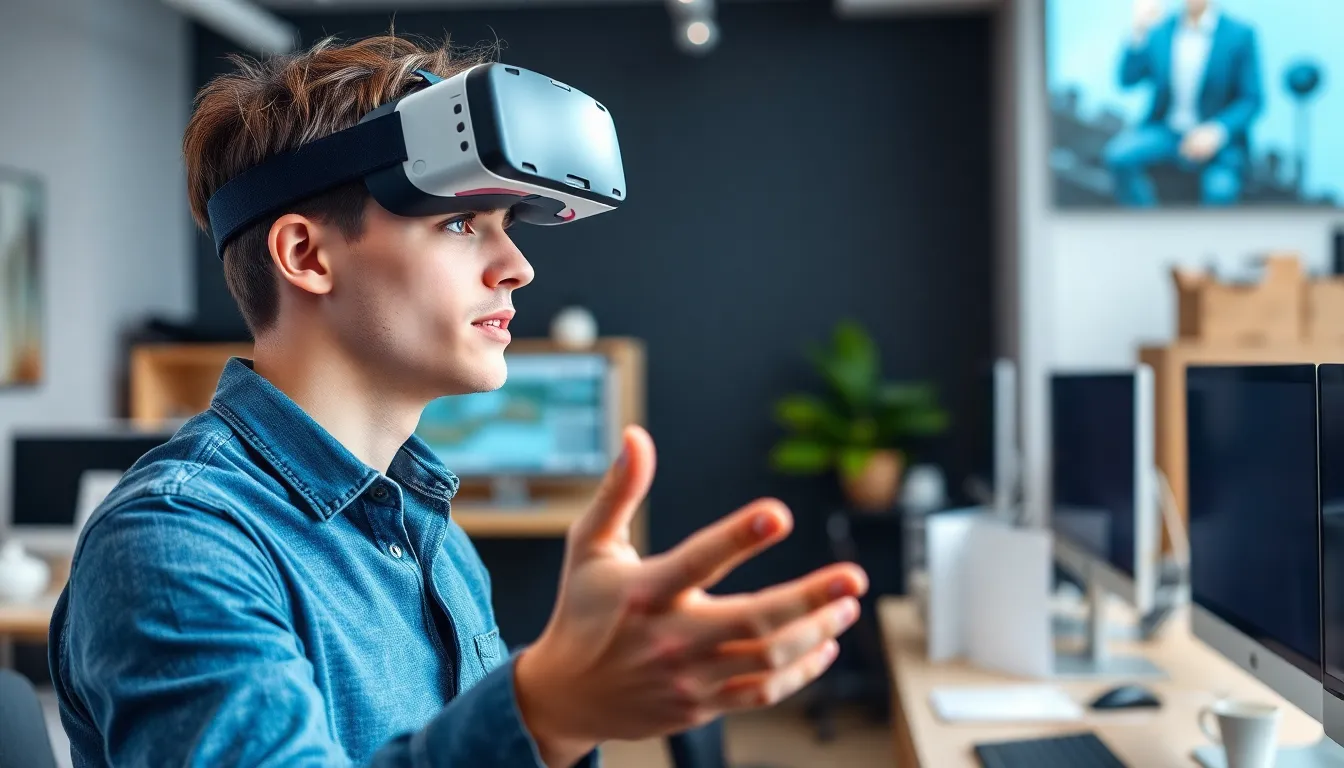In a world where reality often feels a bit too mundane, AR and VR developers are the wizards conjuring up immersive experiences that leave us questioning what’s real. Imagine stepping into a virtual realm where you can battle dragons, explore distant galaxies, or even attend a meeting in your pajamas—sounds tempting, right? These tech-savvy creators are not just coding; they’re crafting the future of entertainment, education, and beyond.
ar vr developer
An AR VR developer specializes in creating applications that blend the digital and physical worlds. These professionals utilize programming skills and artistic abilities to design immersive experiences across various platforms. With expertise in software development, they focus on integrating computer graphics and spatial awareness into interactive environments.
Developers in this field often work with tools like Unity and Unreal Engine. These platforms allow them to build complex applications that support AR and VR functionalities. They also familiarize themselves with various programming languages like C# and C++. Knowledge of 3D modeling software is essential for creating realistic assets used in these experiences.
Collaboration plays a significant role in the development process. Developers typically work alongside designers, artists, and project managers to bring projects to fruition. They also engage with users directly, gathering feedback to enhance the overall experience. An understanding of user experience (UX) principles helps developers create applications that are intuitive and enjoyable.
Essential skills for AR VR developers include problem-solving, creativity, and an understanding of hardware capabilities. Familiarity with headsets like Oculus Rift and HoloLens is crucial, as these devices often define how applications are experienced. Staying current with industry trends keeps developers ahead in a rapidly evolving technological landscape.
Various industries seek AR VR developers to revolutionize their operations. The gaming industry leads the way, but sectors like education, healthcare, and real estate rapidly adopt these technologies. As AR and VR continue to evolve, developers are positioned to reshape how people interact with digital content, creating experiences that blend seamlessly with daily life.
Skills Required For AR VR Development

AR VR development demands a unique blend of skills. Developers thrive by mastering both technical and creative abilities.
Technical Skills
Proficiency in programming languages like C# and C++ ranks high among essential skills. Developers leverage platforms such as Unity and Unreal Engine to build immersive experiences. Knowledge of 3D modeling and animation tools enhances their capability to create visually stunning environments. Familiarity with hardware, including Oculus Rift and Microsoft HoloLens, is crucial for optimizing applications for specific devices. Understanding user interface design principles helps developers create intuitive and engaging experiences. Keeping abreast of technological advancements in AR VR is vital for staying competitive in the evolving landscape.
Creative Skills
Creativity fosters innovation in AR VR development. Developers must envision captivating narratives that enhance user engagement. Skills in storyboarding and character design contribute to immersive environments that resonate emotionally. Artistic abilities enable them to create unique visual styles that differentiate their applications. Collaboration with designers and artists enhances the overall quality of experiences delivered to users. Creative problem-solving empowers developers to overcome design challenges and enhance user satisfaction. Continuous exploration of new ideas inspires groundbreaking applications that challenge conventional perceptions of reality.
Tools and Technologies Used
AR and VR developers utilize various tools and technologies to create immersive experiences. These tools enhance their capability to blend digital content with physical environments and engage users effectively.
AR Development Tools
AR development relies heavily on specialized software and platforms. Unity stands out as a popular choice, providing robust features for scene creation. Vuforia also plays a significant role, enabling developers to integrate digital content with real-world objects. ARKit and ARCore serve as essential platforms for iOS and Android, respectively, facilitating device-specific functionality. Other tools like Blender and Maya assist in 3D modeling, critical for building engaging AR experiences. Developers leverage SDKs and APIs to maximize interaction levels, ensuring successful implementations across diverse applications.
VR Development Tools
VR development tools differ, with a focus on creating fully immersive environments. Unreal Engine offers advanced rendering capabilities, allowing for stunning graphics and realistic simulations. Oculus SDK is crucial for optimizing experiences for Oculus devices, enhancing user interaction. SteamVR provides compatibility across various hardware, ensuring a broad reach. Additionally, the use of 3D modeling software like 3ds Max or Cinema 4D helps in crafting intricate virtual worlds. Developers frequently apply motion tracking technology to enhance user engagement, ensuring seamless navigation within the virtual space.
Career Opportunities For AR VR Developers
AR VR developers encounter numerous career opportunities across various industries. One notable sector is gaming, where developers create immersive worlds and engaging gameplay experiences. Companies like Electronic Arts and Epic Games consistently seek skilled professionals to enhance the player experience with cutting-edge technology.
Education also provides significant opportunities for AR VR developers. Institutions are increasingly adopting these technologies for interactive learning. Developers design applications that allow students to visualize complex concepts and engage with educational content.
Healthcare benefits from AR VR innovations that improve patient outcomes. Medical professionals utilize simulations for training and therapy, with developers creating realistic scenarios that facilitate learning in surgery and rehabilitation.
Real estate industries leverage AR VR to revolutionize property marketing. By enabling virtual tours, developers assist clients in visualizing spaces remotely. Through this technology, real estate agents can showcase properties more effectively.
Manufacturing utilizes AR VR for training and operational efficiency. Developers contribute to simulations that prepare workers for real-world scenarios while minimizing risks. By implementing AR systems, companies can streamline assembly processes and enhance productivity.
The entertainment industry constantly seeks creative AR VR developers for immersive experiences. Film production companies experiment with augmented environments to captivate audiences, making interactive storytelling possible.
Entrepreneurship presents another avenue for AR VR developers. Startups focusing on innovative solutions often seek individuals to conceptualize and develop groundbreaking applications. Through entrepreneurship, developers can bring unique ideas to life and disrupt markets.
Overall, career opportunities for AR VR developers span diverse fields. As industries continue to embrace these technologies, demand for skilled professionals is poised to grow significantly.
Future Trends In AR VR Development
AR and VR development trends indicate significant advancements in technology, shaping immersive experiences. Increased integration of artificial intelligence enhances user interactions, making environments more responsive and adaptive. Enhanced hardware capabilities improve graphic fidelity and reduce latency, resulting in smoother experiences.
Noteworthy developments in social AR and VR create opportunities for collaborative environments, enabling users to interact and engage in real-time. Multiple industries are beginning to standardize AR and VR tools, promoting cross-platform compatibility. This trend benefits developers by facilitating easier access to a broader user base.
Emerging technologies, such as 5G, enable seamless streaming of high-quality content, expanding possibilities for real-time applications. The rise of mixed reality devices blends physical and virtual elements, providing unique experiences in both realms. Each of these advancements encourages developers to explore innovative use cases across various sectors.
As AR and VR applications focus more on user-centered design, understanding audience needs and preferences becomes crucial. The integration of haptic feedback technologies enhances realism, influencing how users engage with digital environments. Increased demand for customization leads developers to create tailored solutions, addressing specific needs in diverse industries.
Moreover, expanding educational applications revolutionize how students learn, utilizing VR for immersive experiences that enhance concept retention. Similarly, AR applications improve training in healthcare, offering simulations that replicate real-world scenarios. The growing trend of remote work encourages companies to adopt AR and VR for virtual meetings and team collaborations, reshaping workplace dynamics.
Overall, ongoing advancements in AR and VR development prompt professionals to remain agile, embracing new tools and methodologies to stay competitive in this fast-evolving field.
Conclusion
The role of AR VR developers is pivotal in shaping the future of immersive technology. As they blend creativity with technical expertise, these professionals are driving innovation across various industries. From gaming to education and healthcare, their contributions are transforming how people interact with digital content.
With the rapid advancements in tools and technologies, the demand for skilled AR VR developers is only set to increase. Staying abreast of trends like AI integration and enhanced hardware will be crucial for those entering this dynamic field. Embracing these changes will empower developers to create even more engaging and impactful experiences.



![[author] arkit and unity: build a drivable car in augmented reality course](https://wzhi58.com/wp-content/uploads/2024/11/1b145239-102d-43d9-8674-80113a75e375_hGjkhjyx0SxSyWk99mwY3-1024x585.jpeg)